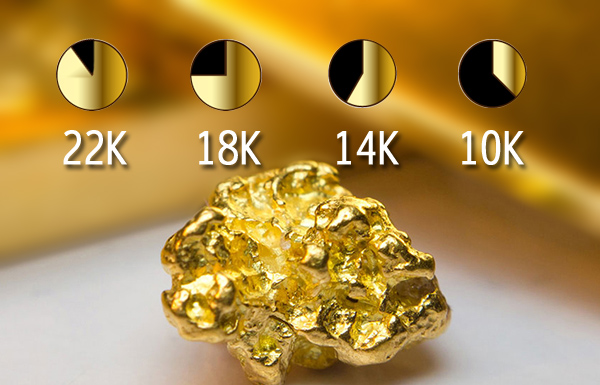What is a Karat? What is AGW?
Updated November 6th 2017

What Is a Karat of Gold?
Understanding gold and its economy can sometimes feel very much like an insider’s game. Whether you’re talking to a salesperson, looking at an advertisement, or reading something on the internet, it can seem like there’s a lot of complicated language being thrown around. You’ve probably heard the term "gold karat" frequently, as well as the mysterious acronym, "AGW." But what do these terms even mean?
Before you begin browsing for your next gold item, we recommend taking a few minutes to read through this guide to either learn or re-educate yourself about some of the basic terminology used in the gold market. Doing so can help you become more equipped to make an intelligent and informed decision that will benefit you in the long run.

What Is "Pure Gold?"
Did you know that most gold today isn’t solid gold? While that might sound like you’re being cheated out of gold content, there’s more to the picture than meets the eye. Pure gold is an extremely soft metal, meaning that anything made out of gold will not be hard or fine. It will be soft and malleable, even prone to warping or bending with time.
To combat this, goldsmiths mix gold with other metals and additive elements. These elements help make the gold hard, durable, and able to withstand the beating that most items eventually take. The gold might be mixed with silver, copper, or something else altogether. The end result is the same — the gold is better for crafting jewelry, coins, and other decorative items.
When we use the term "pure gold," we refer to gold that is 100 percent gold, with no mixed metals or additives.
What Is a Karat?
Because most gold isn’t pure gold, it becomes necessary to have a way to designate how pure or impure gold is. In other words, we need a term that tells us the percentage of different elements in any given amount of gold — what percent is gold and what percent is other metals?
A gold karat is a unit of measurement. There are 24 "possible" karats in any given amount of gold. Therefore, if an item is 24 karat gold, it is a "pure gold karat," meaning nothing has been added to the gold to compromise its purity.
The higher the karat number, the closer the gold is to being pure. The lower the karat number, the more additional materials have been added to the gold. For example, one may see a gold item being advertised as 14K and wonder, "what is 14 karat gold?" This simply means that the gold is 58.3 percent pure gold and 41.7 percent other materials. Likewise, 18K gold is 75 percent pure gold and 25 percent other materials.
It’s important to note that 24 karat gold is the purest gold possible. There is no such thing as 25 or 26 karat gold, so steer clear of any dealer who claims to have a product like that to sell.

High Karat vs. Low Karat
There are a few key differences between high and low karat gold that are worth pointing out:
- Density: The lower the karat, the harder the gold will be. The higher the karat, the softer the gold.
- Tarnish Resistant: Higher karat gold is extremely tarnish-resistant, whereas low karat gold has very little tarnish resistance.
- Color: Higher karat gold will have a much brighter yellow color. Lower karat gold will have a duller yellow shade.
- Monetary Value: An obvious difference — the higher the karat, the more expensive the gold.
Why Does Gold Come in Different Karats?
You might wonder why gold comes in so many different karats. Even if pure gold is difficult to work with, why not have one standard, such as 18K or 22K?
The first answer is price. The higher the purity and karat value of gold, the more expensive it becomes. Because of this, not everyone can afford to buy gold items with an extremely high karat value. Thus, it becomes more practical to have a wide range of karat values and a wide range of possible prices. This way, buyers have the option to purchase either higher or lower karat values based on their budgets.
The second answer is that different karat values are suited to different purposes. Here are some common uses of different karat values of gold.

24K Gold
As previously mentioned, 24K gold is very soft and not necessarily practical for many applications. Because it is 99.9 percent pure, it’s still the most expensive of any gold and has a very distinct bright yellow color. Due to its pliable nature, it’s not suitable for jewelry making. But there are still some good uses for it.
Most gold coins are made of 24K gold, and so are the gold bars kept at Fort Knox. 24K gold is also used in making electronics and some medical devices. For example, since the porous nature of the pure gold improves aeration in the inner ear, 24K gold is used in devices that treat ear infections.
22K Gold
22K gold is 91.67 percent pure gold and 8.33 percent additional elements. This means the gold is 22 parts pure, with the other 2 parts composed of elements like copper, zinc, nickel, and other metals and alloys. The majority of plain gold jewelry is made out of 22K gold, although it isn’t well-suited to heavier, jewel-studded jewelry.
18K Gold
75 percent pure and 25 percent other elements, 18K gold is the perfect combination for crafting elegant, diamond and gemstone-laden jewelry. Because it has a slightly harder and more durable nature than 22K gold, it’s better-equipped to support the added weight of diamonds and gemstones.
Because it’s a smaller karat number, it also tends to be less expensive than 22 and 24 karat gold items. Instead of being a bright yellow color, it’s a slightly duller shade of gold.

14K Gold
Suited for the same purposes as 18K gold, 14K gold is only slightly less pure. Given that it is 58.3 percent pure gold, it’s still high quality and has an excellent color, and it works as a good compromise between quality concerns and budget constraints.
10K Gold
10K gold is strong and durable and has a good color. At 41.6 percent gold it’s a perfect choice for those who have a limited budget but are still looking for a moderate level of quality in their jewelry or other items.
9K Gold
9K gold is 37.5 percent pure gold. The pinks and reds of the copper added to the gold begin to bleed through and show through the gold’s natural yellow. However, 9K gold is a good choice for beginning buyers or those who don’t have a large budget.
8K and Below
Anything lower than 9K has such low gold content that it’s no longer considered gold and cannot legally be sold as such.

Karat vs. Carat
It’s worth noting that the terms karat and carat are pronounced the same. They are both used in the jewelry industry and therefore are easy to confuse.
As opposed to karat, "carat" doesn’t refer to gold at all. It refers to gemstones and is a unit of measurement used to designate a gemstone’s weight and worth. For example, you might buy an 18 karat gold necklace with a 1.5 carat diamond in the pendant.
What About Gold of Other Colors?
If gold becomes brighter and yellower as it becomes purer, where do things like white gold or rose gold come from?
It relates to the combination of other metals and alloys mixed into the gold. To achieve white gold, the pure gold needs to be mixed with metals like silver and palladium. These help bring the gold to an elegant white-ish color. The same is true for rose gold, which is created by adding heavier doses of copper to the mix. In this way, goldsmiths can create many different colors and shades.
A layer of plating atop a gold item can also give it a different color. This is a very temporary plating, however, and it will wear off in time.

What Is AGW?
Another term you might hear tossed around in the gold industry is AGW. While karat is a frequently-used term, AGW is slightly more obscure. However, it’s an important term to learn about before you begin shopping for gold coins or bullion.
AGW stands for Actual Gold Weight. While a karat measures the purity level of a gold piece, the AGW is a measurement of a piece’s gold weight. If you were to take a gold piece and melt it down so that only the gold remained, that weight measurement would be the AGW of the original gold piece.

What Unit Is AGW Measured in?
The most common unit used to designate AGW is called a troy ounce. Troy ounces, the standard unit of measure for precious metals and gemstones, are heavier than regular ounces.
Unlike regular ounces (known as avoirdupois ounces) where 16 ounces equals one pound, there are only 12 troy ounces per troy pound. A troy ounce is also heavier than a regular ounce.
One troy ounce is equal to 31.1035 grams, whereas one traditional (avoirdupois) ounce is equal to only 28.3495 grams. Using these conversion rates, it’s easy enough to convert troy ounces into units that may be more familiar to you. One troy ounce is equal to 1.09714286 traditional ounces. Coins and bullion are measured in troy ounces, as are precious metals spot prices.
What Does This Look Like?
To see examples of how karats and AGW work in real life, let’s consider two different gold coins — the Gold Eagle (22K) and the Gold Buffalo (24K).
Now that you have a better understanding of karats and AGW, you know that the 22-karat Gold Eagle is made up of 22 parts gold and 2 parts other materials, such as silver and copper. The 24-karat Gold Buffalo, on the other hand, is 99.99 percent pure gold. This means that if you were to hold a 1oz Gold Buffalo in one hand and a 1oz Gold Eagle in the other, the Gold Eagle would feel heavier and more durable.
However, just because these two coins have a different karat value doesn’t mean they have a different AGW. As it happens, these two coins have exactly the same AGW. They both contain one troy ounce of gold. The only difference is that the Gold Eagle also contains a small amount of other metals that make it stronger and more durable, and thus, slightly heavier.
Why Does This Matter?
Gold is like any other industry. By educating yourself on the basic terms and concepts, you can have a better idea of what to expect when purchasing precious metal coins and bullion and how to determine the product’s value.

Find a Dealer You Can Rely On
When it comes to the gold industry, it’s very important to deal with a company that has a reputation for honest, responsible dealings. If you’re looking for such a dealer, we hope you’ll consider our services here at Mint State Gold. With over 50 years of experience in the gold business, we’re excited to help people at all different stages of their coin collecting or precious metal investing experience.
In addition to helping you search for the right gold products to purchase, we also help you find the best deals for selling your coins. And our service doesn’t end with buying and selling — we believe it’s important to provide education on coins, investing, collecting, and the potential highs and lows that collectors and investors may encounter.
Whether you’re an experienced pro or looking to get started, we think you’ll love what we have to offer. Browse our shop of gold, silver, platinum, and palladium coins and bullion products, and other collectible items and see what catches your eye. If you have any questions about karat value, AGW, or anything else related to precious metal investments or coin collecting, contact us on our website or call us at 1-888-454-0444.







